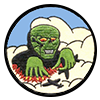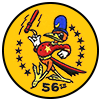3rd Air Force - 54th Pursuit Group - 54th Fighter Group
42nd FS - 56th FS - 57th FS
Constituted as 54th Pursuit Group (Interceptor) on 20 Nov 1940. Activated on 15 Jan 1941. Trained with P-40's. Served as a part of the defense force for the northwest Pacific coast during the first few months of the war. Redesignated 54th Fighter Group in May 1942. The air echelon, equipped with P-39's, served in Alaska against the Japanese forces that invaded the Aleutian Islands during the summer of 1942, and for these operations the group received a DUC. The air echelon returned to the US in Dec 1942 and rejoined the group, which had been assigned to Third AF, and which became a replacement training unit for P-51 pilots. Disbanded on 1 May 1944.
Reconstituted and redesignated 54th Fighter Group (Air Defense), on 20 Jun 1955. Activated on 18 Aug 1955. Assigned to Air Defense Command and equipped with F-86's.
Squadrons: 42d Fighter Squadron: 1941-1944; 1955-. 56th Fighter Squadron: 1941-1944. 57th Fighter Squadron: 1941-1944.
Stations: Hamilton Field, Calif, 15 Jan 1941; Everett, Wash, 26 Jun 1941; Harding Field, La, 31 Jan 1942; Bartow AAFld, Fla, 11 May 1943-1 May 1944. Greater Pittsburgh Aprt, Pa, 18 Aug 1955-.
Commanders: Capt Harry A Hammond, 15 Jan 1941; Col Phineas K Morrill, Feb 1941; Col Charles M McCorkle, 12 Sep 1942; Lt Col George B Greene Jr, 11 Aug 1943; Lt Col Ward W Harker, 17 Sep 1943; Col Joseph S Holtoner, 6 Mar-1 May 1944. Col Edward F Roddy, 1955-.
Campaigns: American Theater.
Decorations: Distinguished Unit Citation: Aleutian Islands, [Jun]-4 Nov 1942.
Insigne: Shield: Per bend of the light blue sky and azure, over a bomb, bend sinisterwise, a lightning flash, palewise, gules, fimbriated argent; a bend of the last superimposed over all and charged with a jet aircraft, in chief, sable, with vapor trail of the third; all between an increscent moon and a radiant sun in fess all of the fourth. (Approved 8 Mar 1957.)
42nd Fighter Squadron
World War II
no information at this stage help needed
Lineage
20 Nov 1940 – Constituted 42d Pursuit Squadron (Interceptor)
15 Jan 1941 – Activated
15 May1942 – Redesignated 42d Fighter Squadron
1 May1944 – DisbandedAssignments
15 Jan 1941 - 1 May 1944 – 54th Pursuit (later Fighter) Group
Stations
15 Jan 1941 – Hamilton Field, Ca
26 Jun 1941 – Everett, Wa
31 Jan 1942 – Harding Field, La
– Detachments operated from: Ontario, Ca - 28 May - 8 Jun 42, Kodiak, Ak - 12 Jun - 8 Sep 42, Adak, Ak - 10 Sep - 12 Dec 4256th Fighter Squadron
World War II
The 56th PS was activated on 15 January 1941, defending the war industry in Southern California until June 1942.
On 20 June 1942, the 56th (now) Fighter Squadron, took their Bell P-39 Airacobras to Nome, Alaska, where they won a Distinguished Unit Citation for operations against the Japanese in November 1942. In 1943, the 56th FS returned to the ConUS, and were based at Bartow Army Air Base, Florida, where they converted to North American P-51 Mustangs. One year later, on 1 May 1944, the 56th FS was disbanded.
Re-constituted and activated at Selfridge AFB, Michigan in November 1952, the 56th (now) Fighter Interceptor Squadron was assigned to the 4708th Air Defense Wing, and equipped with North American F-86F Sabres. In February 1953, the 56th FIS began conversion to F-86D interceptors, and was assigned to the 575th Air Defense Group.
On 18 August 1955, under Project ARROW, the 56th FIS designation was transferred from Selfridge AFB to Wright-Patterson AFB, Ohio, initially under operational control of the 4706th Air Defense Wing, then the 58th Air Division (Air Defense) on 1 March 1956, where the squadron was the primary air defense unit for southwestern Ohio and the research facilities at Wright-Patterson.
In the Spring of 1957, the 56th FIS began re-equipping with the North American F-86L Sabre, an improved version of the F-86D which incorporated the Semi Automatic Ground Environment, or SAGE. The unit became proficient with both the F-86L and SAGE, and won an Air Defense Command "A" award for live rocket SURE-FIRE missions in the late summer of 1957.
The transition into the F-86L was short-lived however, as the squadron began transition into the "missile-witha-man-in-it", the Lockheed F-104A in May 1958, becoming the 2d ADC sqiadron equipped with the Starfighter. In addition, the squadron received the two-seat, dual-control, combat trainer F-104B. The performance of the F-104B was almost identical to that of the F-104A, but the lower internal fuel capacity reduced its effective range considerably. The 56th FIS was now under operational control of 30th Air Division (Air Defense), before being transferred to the Detroit Air Defense Sector in April 1959.
It was found that the F-104A was not very well suited for service as an interceptor. Its low interception range was a problem for North American air defense, and its lack of all-weather capability made it incapable of operating in conjunction with the SAGE (Semi-Automatic Ground Environment) system. Service with the ADC was consequently quite brief, and the F-104As of the 56th FIS were transferred to the Air National Guard.
With the transfer of the Starfighters, ADC shut down operations at Wright-Patterson and the 56th FIS was deactivated at Wright-Patterson on 1 March 1960.
Lineage
Constituted 56th Pursuit Squadron (Interceptor) on 20 November i940
Activated on 15 January 1941
Redesignated 56th Fighter Squadron on 15 May 1942
Disbanded on 1 May 1944
Reconstituted, and redesignated 56th Fighter-Interceptor Squadron, on 14 November 1952
Activated on 27 November 1952
Discontinued on 1 March 1960.Assignments
54th Pursuit (later Fighter) Group, 15 January 1941 – 1 May 1944
4708th Defense Wing, 27 November 1952
575th Air Defense Group, 16 February 1953
4706th Air Defense Wing, 18 August 1955
58th Air Division, 1 March 1956
30th Air Division, 1 September 1958
Detroit Air Defense Sector, 1 April 1959 – 1 March 1960Stations
Hamilton Field, California, 15 January 1941
Paine Field, Washington, 26 June 1941
Harding Army Air Field, Louisiana, 31 January 1942
Detachment operated from: Santa Ana Army Air Base, California, 28 May – 12 June 1942
Detachment operated from: Nome, Alaska Territory, 20 June – 20 October 1942
Detachment operated from: Elmendorf Field, Alaska Territory, 23 October – 21 December 1942
Bartow Army Airfield, Florida, May 1943-1 May 1944
Selfridge AFB, Michigan, 27 November 1952
Wright-Patterson AFB, Ohio, 18 August 1955 – 1 March 1960.57th Fighter Squadron
World War I
The 57th Pursuit Squadron was established on 1 January 1941 at Hamilton Field, California. Along with the 42nd and 56th squadrons it was a part of the 54th Pursuit Group. It was formed with a cadre from the 35th Pursuit Group. The squadron operated both Bell P-39 Aircobras and Curtiss P-40 Warhawks alongside each other which was rather unusual, and in June 1942 it was sent to Alaska. It was first based at Elmendorf Field, Anchorage and according to the official records, it would seem that it did not in itself take any part in the action against the Japanese in the Aleutians, but a detachment of eleven of the pilots saw service with the 42d which was based at Kodiak NAS, Adak and between them got three confirmed victories and two probables. On 4 August 1942, the 57th was moved to Kodiak NAS, Adak and there replaced the 42d. All its pilots were rotated to Adak to gain combat experience.
The assignment of the 57th to Alaska came to end on 26 November 1942 and the P-39s were to be flown to Duncan Army Airfield, San Antonio, Texas for depot-level overhaul. With the squadron back at Harding Army Airfield, Baton Rouge, it was reequipped with the North American P-51A Mustang, thereby becoming the first P-51 unit in the AAF. On 12 May 1943 the 54th Group with the 57th and 56th squadrons was transferred to Bartow Army Airfield, Florida. There it became a replacement training group, training P-51 pilots for overseas duty. It reequipped with P-51Bs at Bartow. The 57th squadron was disbanded on 30 April 1944, being replaced by an Army Air Force Base Unit as part of a re-orgazation of training units.
The unit was reactivated under Strategic Air Command on 24 March 1947 as an Air Force Reserve fighter-escort squadron under the reserve 459th Bombardment Group at Davis-Monthan Field, Arizona. It is unclear whether or nor the unit was manned or equipped as the 459th was located at Long Beach Army Air Field, California with B-29 Superfortresses. It was inactivated in June 1959 due to budget reductions.
Aleutian Islands, United States Map
 Editor for Asisbiz: Matthew Laird Acred
Editor for Asisbiz: Matthew Laird Acred
If you love our website please add a like on facebook
Please donate so we can make this site even better !!


